We removed the newspaper remnants from the combined Oceanic815 hive. They look like they are doing very well. We added a honey super. I think I’ve waited too long to do this in previous years, so it may be too early but I’m giving it a try. I the other 2 overwintered hives looked strong as well. I added a honey super to The Black Rock.
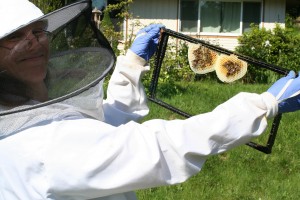 The swarm hive is doing great on the cutout frames. They are building up some beautiful, straight combs and have brood, pollen and some honey too. Fed 3 quarts more 1:1 syrup.
The swarm hive is doing great on the cutout frames. They are building up some beautiful, straight combs and have brood, pollen and some honey too. Fed 3 quarts more 1:1 syrup.
If you look at closeups of some of these photos you can see that it looks like they are starting out using the cell size on the remnant strip of plastic foundation. This is not good. I may need to do something different for a starter strip.

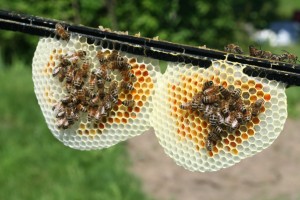
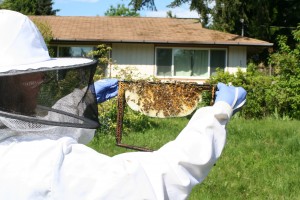
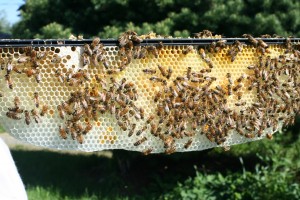
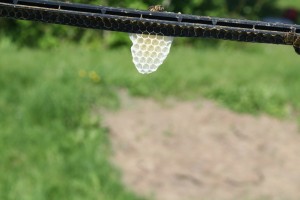
The new hive is very busy. They have consumed about half the syrup. We’re enjoying watching them and curious about how they are building up but don’t want to disturb them too soon.
Philip called me mid day yesterday, he had captured a swarm by the Snohomish River.
 It was Mother’s Day, Sunday, we were already headed home so it could not have happened at a better time.
It was Mother’s Day, Sunday, we were already headed home so it could not have happened at a better time.
We combined the two weak hives by removing the nearly empty second brood box from each. At the same time we swapped some of the moldiest frames so we could get a good cleanup done at the same time. What we are left with is a very healthy hive with a sufficient population. And 2 queens to boot. Wish I could watch the drama. We put a sheet of newspaper between the 2 brood chambers. They will chew through the paper in a few days. The queen from the top chamber will usually win out, I’ve heard. Hive4 was placed on top of ‘Oceanic815′.
The next step was to cut out the centers of the plastic frames. We removed the old brood nest comb, and used a few different methods to cut the centers out of the frames, leaving about 1/4 inch of the foundation at the top as a starter. We wondered if they would use the cell size remnant to base their foundationless cell size on. We only broke one frame out of the 20 cutouts we did.
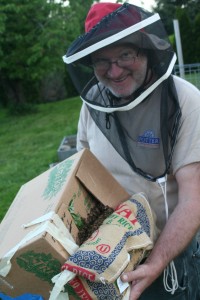 It was dark when Philip arrived with the swarm. He had placed them in a cardboard box with a piece of burlap taped to the top. I did not want to mess with them in the dark. Although swarming bees are very unlikely to become aggressive, I have heard stories of bees extremely disgruntled at being disturbed at night and didn’t want to experience it myself. So we just lowered the cardboard box into the empty hive box on top of the waiting hive, opened the top of the cardboard box, put the hive cover on, and left them for the night.
It was dark when Philip arrived with the swarm. He had placed them in a cardboard box with a piece of burlap taped to the top. I did not want to mess with them in the dark. Although swarming bees are very unlikely to become aggressive, I have heard stories of bees extremely disgruntled at being disturbed at night and didn’t want to experience it myself. So we just lowered the cardboard box into the empty hive box on top of the waiting hive, opened the top of the cardboard box, put the hive cover on, and left them for the night.
This morning, Gavin and I got out early before work and dumped them into the lower box with the waiting cut-out plastic frames.
We brushed the bees from the blackberry branches they were clinging to, and removed the beautiful little 3″ piece of comb they had built in the cardboard box overnight.
Then we installed the hive feeder with 1:1 sugar water. The bees look healthy and it is a good sized swarm.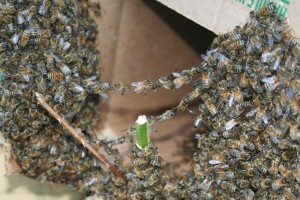
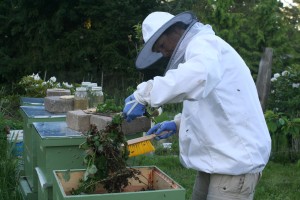
I am considering combining the two weak hives and cutting out the centers of the brood frames in the new empty hive to try foundationless natural cell. The cells in my one-piece plastic Pierco frames are 5.2mm. I would like to try a method recommended by Michael Bush. I read his book this winter and so many of his methods make sense.
http://www.bushfarms.com/beesfoundationless.htm
http://www.bushfarms.com/beesnaturalcell.htm
Here are my 4 hives as of May 12th 2012:
1.The Black Rock: Started from a 2011 split of my original The Others hive. They initially killed 2 introduced commercial queens, then, after being queenless for months, accepted a queen from the secondary swarm from last years new package hive ‘Oceanic815′. Or, the queen came off of the frame of brood with a queen cell on it that I transferred after the first swarm, weeks before I placed the secondary swarm in the hive. The bees are more active earlier in the day than the other hives, and they are a darker color.
2. The Others: This is the original surviving colony from 2010. My other 2010 colony, FlashMob, did not make it through the first winter. They do not have their original queen, as this hive has swarmed a few times.
3. Oceanic815: Stared in 2011 as a 4# package. Built up very quickly last year and had a few swarms last year. One started a new hive, and the other supplemented The Black Rock and provided a queen.
4. 4th hive does not have a name. Stared from a swarm from the new package hive last year – 2011.
Status of hives as of May 11:
1. The Black Rock is the busiest hive. Early risers. Queen spotted. Lots of eggs, lots of capped brood, a little honey. I removed a frame of capped brood to build up one of the weak hives.
2. The Others Busy hive. Queen spotted. Eggs, lots of capped brood, a little honey.
3. Oceanic815 Queen spotted. Sparse population. A few eggs. A little brood. Lots of honey. Lower brood box is empty with some mold. We reversed the brood boxes.
4. 4th hive No queen spotted. A few eggs. Very little brood. Sparse population. Lots of honey.
So all 4 survived the winter. This is a victory. And all have new eggs. This is good.
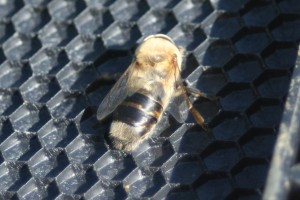 This is a drone from The Black Rock. They look a little different than the drones from the other hives. Look at the cute grey fuzz on his ‘butt’.
This is a drone from The Black Rock. They look a little different than the drones from the other hives. Look at the cute grey fuzz on his ‘butt’.
Click on the picture to view a larger photo so you can get a better look. He’s really quite enchanting.
 The swarm hive is doing great on the cutout frames. They are building up some beautiful, straight combs and have brood, pollen and some honey too. Fed 3 quarts more 1:1 syrup.
The swarm hive is doing great on the cutout frames. They are building up some beautiful, straight combs and have brood, pollen and some honey too. Fed 3 quarts more 1:1 syrup.








